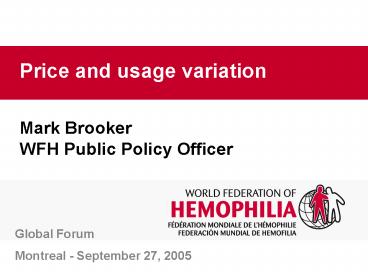Price and usage variation - PowerPoint PPT Presentation
1 / 20
Title: Price and usage variation
1
Price and usage variation
Mark BrookerWFH Public Policy Officer
- Global Forum
- Montreal - September 27, 2005
2
WFH Annual Global Survey
- 6th WFH Global survey
- Data reported by WFH Member organizations in
collaboration with clinicians and health
officials - Demographic information on patient population,
blood borne infection, access to treatment
products, health care system, and use and cost of
factor concentrates - Other data sources
- World Bank for population, GDP and health care
spending - OECD for PPP figures
3
WFH Annual Global Survey
- Number of countries in survey 96
- Percentage of world population covered by 2004
survey 85 - Number of people identified with hemophilia A and
B 120,812 - Number of people identified with von Willebrand
disease 43,334 - Number of people identified with other bleeding
disorders 11,384 - Total number of people with bleeding disorders
identified 175,530
4
WFH Annual Global Survey product use
- Usage data caveats
- Figures are not independently verified quality
varies - Total annual usage may actually be total annual
purchase - Data may not include all CFCs some products may
be acquired through alternate sources
5
WFH Annual Global Survey product use
- Factor VIII use
- 49 countries reporting
- Total reported consumption
- of factor VIII concentrates in 2004
- 1,576,859,835 IU
6
WFH Annual Global Survey product use
- Per capita use by GNP
- Per capita factor VIII usage (GNP per capita
above US10,000) - 5.32 IU
- Per capita factor VIII usage (GNP between
US2000-US10,000) - 0.75 IU
- Per capita factor VIII usage (GNP below
US2,000) - 0.08 IU
7
WFH Annual Global Survey product use
- Factor IX use
- 49 countries reporting
- Total reported consumption
- of factor IX concentrates in 2004
- 236,679,516 IU
8
WFH Annual Global Survey product use
- Per capita factor IX usage GDP
- Per capita factor IX usage (GNP above US10,000)
- 0.72 IU
- Per capita factor IX usage (GNP between
US2000-US10,000) - 0.13 IU
- Per capita factor IX usage (GNP below US2,000)
- 0.02 IU
9
WFH Annual Global Survey prices
10
WFH Annual Global Survey prices
- Prices of 17 products
- 16 countries buying both factors VIII and IX, at
least 3 products, and reporting prices - Caveats
- Figures are not independently verified quality
varies - Different ways of paying (prices from different
points in the chain) - Reported price of CFCs may actually be an
arbitrary figure to cover other costs - Exchange rates prices reported in local
currency exchange rate from the middle of the
year - Volume purchased not known
11
WFH Annual Global Survey prices
- Purchasing Power Parity (PPP)
- PPP measures how much a currency can buy in
terms of an international measure (usually
dollars), since goods and services have different
prices in some countries than in others. PPP
exchange rates are used in international
comparisons of standard of living. - (Source for PPP figures OECD)
12
WFH Annual Global Survey prices
- Sample price ranges for individual factor VIII
products
13
WFH Annual Global Survey prices
- Sample price ranges for individual factor IX
products
14
WFH Annual Global Survey prices
15
WFH Annual Global Survey prices
16
WFH Annual Global Survey prices
17
WFH Annual Global Survey prices
18
WFH Annual Global Survey prices
19
Price and usage variation
- Conclusions
- A broad range of prices paid from 0.25 to about
1.75. - Median prices from 0.60 to 1.00
- Comparing prices using PPP narrows the range of
price differences. But even using PPP, as a
proportion of per capita income, the cost of
products is significantly higher in the
developing world.
20
Price and usage variation
- Thank you
- Dr. Bruce Evatt
- The volunteers who provide the Global Survey data































